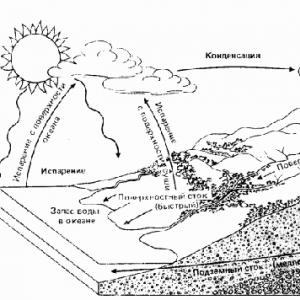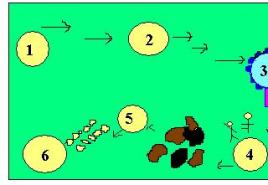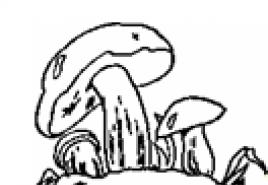Types of ecosystems in nature. What is an ecosystem An example of an artificial ecosystem is
Steppe, deciduous forest, swamp, aquarium, ocean, field - any item from this list can be considered an example of an ecosystem. In our article, we will reveal the essence this concept and consider its components.
Ecological communities
Ecology is a science that studies all facets of the relationships of living organisms in nature. Therefore, the subject of its study is not a separate individual and the conditions of its existence. Ecology considers the nature, result and productivity of their interaction. So, the totality of populations determines the features of the functioning of the biocenosis, which includes whole line biological species.
But under natural conditions, populations interact not only with each other, but also with a variety of conditions. environment. Such an ecological community is called an ecosystem. To refer to this concept, the term biogeocenosis is also used. Both the miniature aquarium and the boundless taiga are an example of an ecosystem.
Ecosystem: definition of the concept
As you can see, an ecosystem is a fairly broad concept. From a scientific point of view, this community is a combination of elements of wildlife and abiotic environment. Consider such as the steppe. This is an open grassy area with plants and animals that have adapted to the conditions of cold winters with little snow and hot dry summers. In the course of adaptation to life in the steppe, they developed a number of adaptation mechanisms.
So, numerous rodents make underground passages in which they store grain reserves. Some steppe plants have such a modification of the shoot as a bulb. It is typical for tulips, crocuses, snowdrops. Within two weeks, while there is enough moisture in the spring, their shoots have time to grow and bloom. And they experience an unfavorable period underground, eating at the expense of previously stored nutrients and the water of a fleshy bulb.
Cereal plants have another underground modification of the shoot - the rhizome. Substances are also stored in its elongated internodes. Examples of steppe cereals are bonfire, bluegrass, hedgehog, fescue, bent grass. Another feature is the narrow leaves that prevent excessive evaporation.

Ecosystem classification
As you know, the boundary of an ecosystem is established by a phytocenosis - a plant community. This feature is also used in the classification of these communities. So, the forest is a natural ecosystem, examples of which are very diverse: oak, aspen, tropical, birch, fir, linden, hornbeam.
Another classification is based on zonal or climatic features. Such an example of an ecosystem is a community of a shelf or sea coasts, rocky or sandy deserts, floodplain or subalpine meadows. The totality of similar communities different type make up the global shell of our planet - the biosphere.

Natural Ecosystem: Examples
There are also natural and artificial biogeocenoses. Communities of the first type function without human intervention. A natural living ecosystem, examples of which are quite numerous, has a cyclic structure. This means that plants are again returned to the system of the circulation of matter and energy. And this despite the fact that it necessarily passes through a variety of food chains.

Agrobiocenoses
Using Natural resources, man has created numerous artificial ecosystems. Examples of such communities are agrobiocenoses. These include fields, vegetable gardens, orchards, pastures, greenhouses, forest plantations. Agrocenoses are created to obtain agricultural products. They have the same elements of food chains as the natural ecosystem.
Producers in agrocenoses are both cultivated and weed plants. Rodents, predators, insects, birds are consumers, or consumers organic matter. And bacteria and fungi represent a group of decomposers. A distinctive feature of agrobiocenoses is the mandatory participation of a person, who is a necessary link in the trophic chain and creates conditions for the productivity of an artificial ecosystem.

Comparison of natural and artificial ecosystems
Artificial ones, which we have already considered, have a number of disadvantages compared to natural ones. The latter are characterized by stability and the ability to self-regulate. But agrobiocenoses cannot exist for a long time without human participation. So, either a vegetable garden independently produces no more than a year, perennial herbaceous plants - about three. The record holder in this regard is the garden, the fruit crops of which are able to develop independently up to 20 years.
Natural ecosystems receive only solar energy. In agrobiocenoses, humans introduce its additional sources in the form of tillage, fertilizers, aeration, weed and pest control. However, many cases are known when human economic activity also led to adverse consequences: salinization and waterlogging of soils, desertification of territories, and pollution of natural shells.

Ecosystems of cities
On present stage development, man has already made significant changes in the composition and structure of the biosphere. Therefore, a separate shell is isolated, directly created by human activity. It's called the noosphere. Recently, such a concept as urbanization has been widely developed - increasing the role of cities in human life. They are already home to more than half of the world's population.
The ecosystem of cities has its own distinctive features. In them, the ratio of elements is violated, since the regulation of all processes associated with the transformation of substances and energy is carried out exclusively by man. Creating for himself all possible benefits, he creates a lot of unfavorable conditions. Polluted air, transportation and housing problem, high level morbidity, constant noise adversely affect the health of all urban residents.
What is succession
Very often within the same area there is a successive change. This phenomenon is called succession. A classic example of an ecosystem change is the appearance of a deciduous forest in place of a coniferous one. Due to the fire in the occupied territory, only seeds are preserved. But it takes a long time for them to germinate. Therefore, grassy vegetation first appears at the site of the fire. Over time, it is replaced by shrubs, and they, in turn, are deciduous trees. Such successions are called secondary. They arise under the influence of natural factors or human activities. In nature, they are quite common.
Primary successions are associated with the process of soil formation. It is typical for territories deprived of life. For example, rocks, sands, stones, sandy loam. At the same time, conditions for the formation of soils first arise, and only then the remaining components of the biogeocenosis appear.
So, an ecosystem is called a community, which includes biotic elements and They are in close interaction, connected by the circulation of substances and energy.
Examples of natural ecosystems: deciduous forests, tundra, ponds, etc. In each of these ecosystems, you can find all three groups of organisms necessary for a viable ecosystem: these are producers, green plants, macroconsumers - herbivores and predatory animals, microconsumers - decomposers - these are fungi, bacteria that feed on dead plant and animal remains.
Examples of artificial ecosystems: aquarium, biological treatment facilities. Artificial ecosystems are heterotrophic, that is, they consume prepared food. An example of an artificial heterotrophic ecosystem can be a city (see Figure 1.4 in APPENDIX 2).
The city, as an ecosystem, is distinguished by the fact that it is very big role play the input environment and the output environment. The city differs from natural ecosystems:
1) a large influx of concentrated energy from outside (fuel, fossils, electricity),
2) a greater need for the intake of substances from the outside,
3) a more powerful and more toxic waste stream, many of which are synthetic, i.e., more toxic than the feedstock.
The biosphere is the largest ecosystem
The largest ecosystem is biosphere our planet. Biosphere - the area of existence of living matter (Vernadsky V.I.) is the largest ecosystem on Earth. The biosphere includes both living matter and non-living matter ("inert" according to Vernadsky). The biosphere emerged 3.4 - 4.5 billion years ago. It is the result of the interaction of living matter with non-living matter (biota with abiota).
Structure biosphere: lithosphere - top of hard surface earth's crust; hydrosphere - water shell of the Earth (seas, oceans, rivers, lakes): troposphere - lower layers of the earth's atmosphere.
The upper boundary of the biosphere is located at an altitude of ~ 20-25 km, where the ozone layer is most dense, protecting living matter, life from UV radiation. The lower boundary of the biosphere is approximately 2-3 km inland on land and 1-2 km below the ocean floor. During its existence, the biosphere has gone through a difficult path of development - evolution. The main stage was the emergence of life on Earth. There are various hypotheses explaining the fact of the origin of life. Eg:
1. Life arose on Earth as a result of a random combination of substances and suitable conditions (methane, hydrogen + high temperature, UV radiation).
2. The hypothesis of an extraterrestrial origin of life - the so-called. the theory of panspermia, according to which life was brought to Earth from space, etc.
Approximately 1.5 million years ago, a man appeared on Earth, whose origin is also disputed by various theories, such as:
Man was formed as a result of evolution;
Man came from Space, etc.
With the advent of human society, a powerful natural force has appeared that consciously, purposefully, naturally and irreversibly changes all nature, the entire biosphere. In what direction? V. I. Vernadsky, many of whose works are devoted to the future of our planet, saw it this way: “A natural and inevitable stage in the development of the biosphere is the stage reasonable regulation of the relationship between man and nature. At this period of evolution of the biosphere, its development will follow the path noogenesis. The main task of this period is to correct the violations and harm that mankind has caused to nature, to prevent such violations in the future.
Lecture number 6. artificial ecosystems
Natural and artificial ecosystems
In the biosphere, in addition to natural biogeocenoses and ecosystems, there are communities artificially created by human economic activity - anthropogenic ecosystems.
natural ecosystems differ in significant species diversity, exist for a long time, they are capable of self-regulation, have great stability, stability. The biomass and nutrients created in them remain and are used within the biocenoses, enriching their resources.
artificial ecosystems - agrocenoses (fields of wheat, potatoes, vegetable gardens, farms with adjacent pastures, fish ponds, etc.) make up a small part of the land surface, but provide about 90% of food energy.
The development of agriculture since ancient times has been accompanied by the complete destruction of the vegetation cover over large areas in order to make room for a small number of human-selected species that are most suitable for food.
However, initially human activity in an agricultural society fit into the biochemical cycle and did not change the flow of energy in the biosphere. In modern agricultural production, the use of synthesized energy in the mechanical processing of the land, the use of fertilizers and pesticides has increased dramatically. This disrupts the overall energy balance of the biosphere, which can lead to unpredictable consequences.
Comparison of natural and simplified anthropogenic ecosystems
(according to Miller, 1993)
| Natural ecosystem (bog, meadow, forest) | Anthropogenic ecosystem (field, plant, house) |
| Receives, transforms, accumulates solar energy | Consumes energy from fossil and nuclear fuels |
| Produces oxygen and consumes carbon dioxide | Consumes oxygen and produces carbon dioxide when fossil fuels are burned |
| Forms fertile soil | Depletes or poses a threat to fertile soils |
| Accumulates, purifies and gradually consumes water | Uses a lot of water, pollutes it |
| Creates habitats of various kinds wildlife | Destroys the habitats of many species of wildlife |
| Filters and disinfects pollutants and waste free of charge | Produces pollutants and waste that must be decontaminated at the expense of the public |
| Possesses the ability of self-preservation and self-healing | Requires high costs for constant maintenance and restoration |
artificial ecosystems
Agroecosystems
Agroecosystem(from the Greek agros - field) - a biotic community created and regularly maintained by man in order to obtain agricultural products. Usually includes the totality of organisms that live on agricultural land.
Agroecosystems include fields, orchards, vegetable gardens, vineyards, large livestock complexes with adjacent artificial pastures.
A characteristic feature of agroecosystems is low ecological reliability, but high productivity of one (several) species or varieties of cultivated plants or animals. Their main difference from natural ecosystems is their simplified structure and depleted species composition.
Agroecosystems are different from natural ecosystems a number of features:
1. The variety of living organisms in them is sharply reduced to obtain the highest possible production.
On a rye or wheat field, in addition to a cereal monoculture, only a few types of weeds can be found. In a natural meadow, biological diversity is much higher, but biological productivity is many times inferior to a sown field.
Artificial regulation of the number of pests is, for the most part, a necessary condition for maintaining agroecosystems. Therefore, in agricultural practice, powerful means are used to suppress the number of undesirable species: pesticides, herbicides, etc. The environmental consequences of these actions lead, however, to a number of undesirable effects, in addition to those for which they are applied.
2. Species of agricultural plants and animals in agroecosystems are obtained as a result of the action of artificial, and not natural selection, and cannot survive the struggle for existence with wild species without human support.
As a result, there is a sharp narrowing of the genetic base of agricultural crops, which are extremely sensitive to the mass reproduction of pests and diseases.
3. Agro-ecosystems are more open, matter and energy are withdrawn from them with crops, livestock products, and also as a result of soil destruction.
In natural biocenoses, the primary production of plants is consumed in numerous food chains and again returned to the biological cycle in the form of carbon dioxide, water and mineral nutrients.
Due to the constant harvesting and disruption of soil formation processes, with long-term cultivation of monoculture on cultivated lands, soil fertility gradually decreases. This position in ecology is called law of diminishing returns .
Thus, for prudent and rational agriculture, it is necessary to take into account the depletion of soil resources and preserve soil fertility with the help of improved agricultural technology, rational crop rotation and other methods.
The change of vegetation cover in agroecosystems does not occur naturally, but at the will of man, which is not always well reflected in the quality of abiotic factors included in it. This is especially true for soil fertility.
Main difference agroecosystems from natural ecosystems - getting extra energy for normal operation.
Supplementary refers to any type of energy that is added to agroecosystems. This can be the muscular strength of a person or animals, various types of fuel for the operation of agricultural machines, fertilizers, pesticides, pesticides, additional lighting, etc. The concept of "additional energy" also includes new breeds of domestic animals and varieties of cultivated plants introduced into the structure of agroecosystems.
It should be noted that agroecosystems - highly unstable communities. They are not capable of self-healing and self-regulation, they are subject to the threat of death from the mass reproduction of pests or diseases.
The reason for the instability is that agrocenoses are composed of one (monoculture) or less often a maximum of 2–3 species. That is why any disease, any pest can destroy the agrocenosis. However, a person consciously goes to simplify the structure of agrocenosis in order to obtain the maximum yield. Agrocenoses, to a much greater extent than natural cenoses (forest, meadow, pastures), are subject to erosion, leaching, salinization and pest invasion. Without human participation, agrocenoses of grain and vegetable crops exist for no more than a year, berry plants - 3-4, fruit crops - 20-30 years. Then they disintegrate or die.
The advantage of agrocenoses Before natural ecosystems is the production of food necessary for humans and great opportunities to increase productivity. However, they are realized only with constant concern for the fertility of the earth, providing plants with moisture, protecting cultural populations, varieties and breeds of plants and animals from the adverse effects of natural flora and fauna.
All agro-ecosystems of fields, gardens, pasture meadows, gardens, greenhouses artificially created in agricultural practice are human-supported systems.
In relation to communities emerging in agroecosystems, the emphasis is gradually changing due to common development ecological knowledge. The idea of fragmentation, fragmentation of coenotic connections and the ultimate simplification of agrocenoses is being replaced by an understanding of their complex systemic organization, where a person significantly influences only individual links, and the whole system continues to develop according to natural, natural laws.
From an ecological point of view, it is extremely dangerous to simplify the natural environment of a person, turning the entire landscape into an agricultural one. The main strategy for creating a highly productive and sustainable landscape should be to preserve and increase its diversity.
Along with the maintenance of highly productive fields, special care should be taken to preserve protected areas that are not subject to anthropogenic impact. Reserves with a rich species diversity are a source of species for communities recovering in successional series.
Target: to characterize the features of the composition and ongoing processes in the artificial ecosystem.
Issues of input control:
1. What is an ecological pyramid and what are the directions of natural selection at each of its steps?
2. What is the significance of its species diversity for the sustainability of the biogeocenosis?
3. What indicators of the action of abiotic factors can inhibit the vital activity of plants or animals?
General information: Ecosystem, or ecological system(from other Greek οἶκος - dwelling, residence and σύστημα - system) - biological system, consisting of a community of living organisms (biocenosis), their habitat (biotope), a system of connections that exchanges matter and energy between them. One of the basic concepts of ecology. An example of an ecosystem is a pond with plants, fish, invertebrates, microorganisms that make up the living component of the system, a biocenosis living in it. The pond as an ecosystem is characterized bottom sediments certain composition, chemical composition(ionic composition, concentration of dissolved gases) and physical parameters (water transparency, trend of annual temperature changes), as well as certain indicators of biological productivity, trophic status of the water body and specific conditions of this water body. Another example of an ecological system is a deciduous forest in central Russia with a certain composition of forest litter, soil characteristic of this type of forests and a stable plant community, and, as a result, with strictly defined microclimate indicators (temperature, humidity, light) and corresponding to such environmental conditions. complex of animal organisms. An important aspect that makes it possible to determine the types and boundaries of ecosystems is the trophic structure of the community and the ratio of biomass producers, its consumers and biomass-destroying organisms, as well as indicators of productivity and metabolism of matter and energy.
artificial ecosystems- these are ecosystems created by man, for example, agrocenoses, natural economic systems or the Biosphere.
Artificial ecosystems have the same set of components as natural ones: producers, consumers and decomposers, but there are significant differences in the redistribution of matter and energy flows. In particular, human-created ecosystems differ from natural ones in the following ways: fewer species and the predominance of organisms of one or more species (low evenness of species); low stability and strong dependence on the energy introduced into the system by a person; short food chains due to the small number of species;
an open cycle of substances due to the withdrawal of the crop (community products) by man, while natural processes, on the contrary, tend to include as much of the crop as possible in the cycle. Without the maintenance of energy flows by humans in artificial systems, natural processes are restored at one speed or another and a natural structure of ecosystem components and material-energy flows between them is formed.
Equipment: cards with the image of artificial ecosystems.
Work order:
Consider the object given to you and identify the most obvious interactions in the ecosystem, note the environmental factors that they correspond to.
Answer the questions:
1. What is the importance for organisms of other living organisms that live nearby?
2. Name the animals that inhabit the ecosystem. How are they related to the flora of the ecosystem? Is it possible for them to exist without plants?
3. What changes can occur in the ecosystem if, for some reason, algae and higher plants?
4. What organisms form the basis of many food chains in this ecosystem?
5. How does the rule of the ecological pyramid manifest itself in this ecosystem?
6. What other types of relationships, besides food, exist in ecosystems?
7. How can one species ensure the distribution of another or other species?
An ecological system or ecosystem is considered by science as a large-scale interaction of living organisms with their non-living environment. They influence each other, and their cooperation allows life to be sustained. The concept of "ecosystem" is generalized, it does not have a physical size, as it includes the ocean and, and at the same time a small puddle and a flower. Ecosystems are very diverse, they depend on a large number of factors such as climate, geological conditions and human activities.
General concept
To fully understand the term "ecosystem" consider it on the example of a forest. A forest is not just a large number of trees or shrubs, but a complex set of interconnected living and non-living elements (land, sunlight, air) nature. Living organisms include:
- insects;
- lichens;
- bacteria;
- mushrooms.
Each organism performs its clearly defined role, and general work of all living and non-living elements creates a balance for the smooth operation of the ecosystem. Every time an outside agent or a new living being enters an ecosystem, negative consequences can occur, causing destruction and potential harm. The ecosystem can be destroyed as a result of human activity or natural disasters.
Ecosystem types
Depending on the scale of manifestation, there are three main types of ecosystems:
- Macroecosystem. A large system made up of small systems. An example is the desert, or the ocean inhabited by thousands of species of marine animals and plants.
- Mesoecosystem. Ecosystem of a small size (a pond, a forest area or a separate clearing).
- Microecosystem. A small-sized ecosystem that mimics in miniature the nature of various ecosystems (aquarium, an animal corpse, a forest stump, a pool of water inhabited by microorganisms).
The uniqueness of ecosystems is that they do not have clearly defined boundaries. Most often they complement each other or are separated by deserts, oceans and seas.
Man plays a significant role in the life of ecosystems. In our time, to meet its own goals, mankind creates new and destroys existing ecological systems. Depending on the method of formation, ecosystems are also divided into two groups:
- natural ecosystem. It is created as a result of the forces of nature, is able to independently recover and create vicious circle substances from creation to decay.
- Artificial or anthropogenic ecosystem. It consists of plants and animals that live in conditions created by human hands (field, pasture, reservoir, botanical garden).
One of the largest artificial ecosystems is the city. Man invented it for the convenience of his own existence and created artificial energy inflows in the form of gas and water pipelines, electricity and heating. However, an artificial ecosystem requires additional inflows of energy and substances from outside.
global ecosystem
The totality of all ecological systems makes up the global ecosystem -. It is the largest set of interactions between living and inanimate nature On the Earth. It is in balance due to the balance of a huge variety of ecosystems and a variety of species of living organisms. It is so huge that it covers:
- earth's surface;
- the upper part of the lithosphere;
- the lower part of the atmosphere;
- all bodies of water.
Thanks to the constant, the global ecosystem has maintained its vital activity for billions of years.







